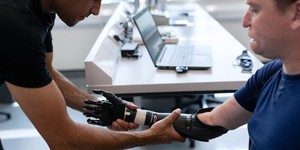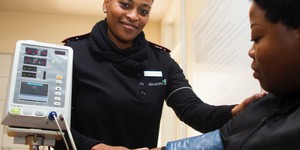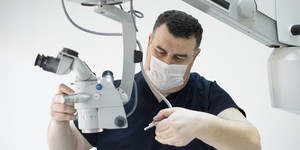Abstract
Doctors use many complicated tools to check the health of patients. But you can make some medical tools at home—like a stethoscope! A doctor uses a stethoscope to listen to a patient's heart. In this science project, you will make three of your own homemade stethoscopes and figure out which stethoscope design works best and why.Summary
Teisha Rowland, PhD, Science Buddies
The designs for the stethoscopes were based on materials from:
- Commonwealth Scientific and Industrial Research Organisation (CSIRO). (n.d.). Try this: Make your own stethoscope. Retrieved September 20, 2011.
- O'Sullivan, E. (2011, January 12). How to make a Homemade Stethoscope. Science With Me!. Retrieved September 20, 2011.
- Bodine, A. (n.d.). How to Make a Homemade Stethoscope. eHow. Retrieved September 20, 2011.
This Project Idea is based on a collaboration with the 2011 Camp G.O.A.L.S for Girls at the Intrepid Sea, Air & Space Museum, New York, NY generously funded by the Motorola Solutions Foundation. The initial concept stems from work by Melissa Przyborowski from the Biomedical Engineering Department at Rutgers University as part of the Camp G.O.A.L.S. team.
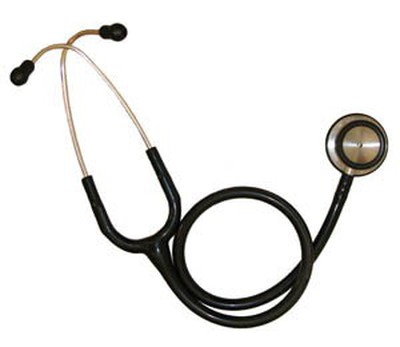
Objective
Build three different homemade stethoscopes and determine which works best and why.Introduction
Ever wonder how the doctor can hear your heart beating? You have probably seen that the doctor uses a tool called a stethoscope to do this. A stethoscope is a long, thin plastic tube that has a small, flat disc or hollow cup on one end and earpieces on the other end. The doctor puts the flat disc or hollow cup on the patient's body, and the earpieces go into the doctor's ears. Look at Figure 1 below to see a photograph of a stethoscope.

Figure 1. A doctor uses a stethoscope, like the one shown above, to hear small sounds inside a patient's body, such as the sound of the heart beating.
Using a stethoscope, the doctor can hear sounds inside a patient's body. How does it work? The disc and the tube of the stethoscope amplify small sounds, or make sounds louder. This amplified sound travels up the stethoscope's tube to the ears of the doctor, who hears the sound through the earpieces.
A doctor can use a stethoscope to listen to a patient's heart, lungs, and other small sounds within the body. Heartbeats can easily be heard using a good stethoscope. Every time a person's heart beats, the heart contracts and pushes blood through the body. This blood is full of oxygen that the heart helps deliver to the rest of the body, while picking up nutrients and taking them to other parts of the body. Very good stethoscopes can let the doctor hear these amplified heartbeats as well as even quieter sounds in a patient's body.
Why would some stethoscopes amplify sound better than others? In this human biology science project, you will make three homemade stethoscopes, each using a different type of tube, and investigate why one stethoscope design works better than other designs.
Terms and Concepts
- Heart
- Stethoscope
- Amplify
- Heartbeats
Questions
- How does a stethoscope work?
- What do doctors use stethoscopes for?
- Why do you think one stethoscope would work better than another?
Bibliography
Have an adult help you do further research by visiting the following websites, which give information about stethoscopes:
- Monackey, H. (2011, September 7). Did you ever wonder how a stethoscope works? WakeMed Voices. Retrieved September 20, 2011.
- Schunk, K. (n.d.). What is a stethoscope and how does a stethoscope work? Acoustic Heart. Retrieved September 20, 2011.
- 3MTM Littmann® Stethoscopes. (n.d.). History: The evolution of an essential tool. Retrieved September 20, 2011.
- KidsHealth. (n.d.). Stethoscope. Retrieved September 22, 2011.
For help creating graphs, try this website:
- National Center for Education Statistics, (n.d.). Create a Graph. Retrieved June 25, 2020.
The designs for the stethoscopes were based on materials from:
- Commonwealth Scientific and Industrial Research Organisation (CSIRO). (n.d.). Try this: Make your own stethoscope. Retrieved September 20, 2011.
- O'Sullivan, E. (2011, January 12). How to make a Homemade Stethoscope. Science With Me!. Retrieved September 20, 2011.
- Bodine, A. (n.d.). How to Make a Homemade Stethoscope. eHow. Retrieved September 20, 2011.
Materials and Equipment
- Large plastic funnels (3)
- Small plastic funnels (3)
- Tip: one option is to buy 3 funnel sets. Use one large and one small funnel from each set.
- Plastic tubing, at least as long as the cardboard tube; available at hardware stores and aquarium supply stores
- A cardboard tube from a paper-towel roll
- A pen that can write on plastic
- A pair of strong scissors or utility knife
- Small garden hose, at least as long as the cardboard tube
- Electrical tape
- Duct tape
- A helper
- Lab notebook
- Optional: Graph paper
Experimental Procedure
Making Three Different Stethoscopes
In this part of the science project, you will make three different homemade stethoscopes.
- Make the first stethoscope with a large funnel, a small funnel, and the plastic tubing. You can see a picture of this stethoscope in Figure 2 below.
- Cut the plastic tubing so that it is exactly as long as the cardboard tube.
- Lay the tubing flat against the cardboard tube. Line one end of the plastic tubing up with one end of the cardboard tube. Where the plastic tubing lines up with the other end of the cardboard tube, mark this point on the tubing with a pen.
- Have an adult help you cut the plastic tubing where you marked it with the pen. The cut tubing should be the same length as the cardboard tube.
- Put a small funnel in one end of the tubing, and a large funnel in the other end.
- If it is hard to put the funnels in the tubing, soak the tubing in warm water to soften the plastic and try again. If this does not work, tape the tubing to the funnels. Make sure that the tape is holding the funnel and tubing together tightly.
- Cut the plastic tubing so that it is exactly as long as the cardboard tube.
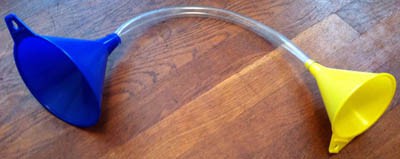 Image Credit: Image by Teisha Rowland, Science Buddies. / Science Buddies
Image Credit: Image by Teisha Rowland, Science Buddies. / Science Buddies
Figure 2. The first homemade stethoscope design connects two funnels, one large and one small, together using plastic tubing.
- Make the second stethoscope with a large funnel, a small funnel, the small garden hose, and electrical tape. You can see a picture of this stethoscope in Figure 3 below.
- Cut the hose so that it is exactly as long as the cardboard tube.
- Lay the hose flat against the cardboard tube. Line one end of the hose up with one end of the cardboard tube. Where the hose lines up with the other end of the cardboard tube, mark this point on the hose with a pen.
- Have an adult help you cut the hose where you marked it. The cut hose should be the same length as the cardboard tube.
- Put a small funnel in one end of the hose, and a large funnel in the other end.
- Tape the funnel and hose together with electrical tape.
- Cut the hose so that it is exactly as long as the cardboard tube.
 Image Credit: Image by Teisha Rowland, Science Buddies. / Science Buddies
Image Credit: Image by Teisha Rowland, Science Buddies. / Science Buddies
Figure 3. The second homemade stethoscope design connects two funnels, one large and one small, together using a piece of garden hose. Electrical tape is used to securely attach the funnels to the hose.
- Make the third stethoscope with a large funnel, a small funnel, the cardboard tube, and duct tape. You can see a picture of this stethoscope in Figure 4 below.
- Put a small funnel in one end of the cardboard tube, and a large funnel in the other end.
- Tape the funnel and cardboard together using duct tape.
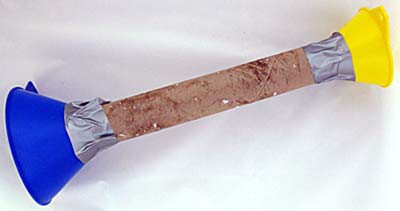 Image Credit: Image by Teisha Rowland, Science Buddies. / Science Buddies
Image Credit: Image by Teisha Rowland, Science Buddies. / Science Buddies
Figure 4. The third homemade stethoscope design connects two funnels, one large and one small, together using a cardboard tube and duct tape.
Testing Your Stethoscopes
- Listen to the heartbeat of a helper using each one of your homemade stethoscopes. If there are other noises in the room, it can be difficult to hear using the stethoscope, so make sure you are in a quiet place. Also, thick clothing may make it difficult to hear the heartbeat.
- Place the large funnel of the stethoscope on your helper's chest, over where his or her heart is.
- Put the small funnel against your ear, covering it.
- Listen for your helper's heartbeat.
- Which stethoscope made it easiest for you to hear your helper's heartbeat? Which stethoscope was the hardest to hear your helper's heartbeat with? Make a data table in your lab notebook like Table 1 below. Write down in your table how loud the heartbeat sounds were for each stethoscope. Write down that the heartbeat sounds were "soft," "medium," or "loud."
| Stethoscope Name | How Loud the Heartbeats Are | Number Score |
|---|---|---|
| First Stethoscope | ||
| Second Stethoscope | ||
| Third Stethoscope |
- Score how loud each heartbeat sound was with a number. For example, "soft"= 1, "medium"= 2, and "loud"= 3. Using these numbers, make a bar graph of how loud the heartbeat sounds were using each stethoscope.
- You can make a graph by hand or use a website like Create a Graph to make a graph on the computer and print it.
- Put each stethoscope's number on the x-axis (the horizontal axis going across) and how loud the heartbeats were on each stethoscope on the y-axis (the vertical axis going up and down).
- For example, a "soft" heartbeat will be low on the y-axis, whereas a "loud" heartbeat will be high on the y-axis.
- Why do you think one of the stethoscope designs worked better than another design? How do you think the type of tubing used in the design might have made it work better?
Ask an Expert
Global Connections
The United Nations Sustainable Development Goals (UNSDGs) are a blueprint to achieve a better and more sustainable future for all.
Variations
- You probably just found that some stethoscope designs work better than others. But why is this? What goes into making a good stethoscope design? To investigate how you can improve on a stethoscope design, visit Engineering Design Process page.
- Make one of the stethoscopes again but find something to change. For example, use longer or shorter tubing, or tubing of a different material or size, or a different size funnel. How does this change how well the stethoscope works? Did it make it better or worse?
- Use your best homemade stethoscope and measure your helper's heart rate. The heart rate is the number of times the heart beats in one minute, or beats per minute (bpm). Take your helper's pulse and compare this to the heart rate you got using your stethoscope. To learn about heart rates and taking someone's pulse, see the Science Buddies' Project Idea A Day in the Life of Your Heart.
- If you have seen and felt a real doctor's stethoscope before, think about how the best homemade design you tested is different from a real stethoscope. What parts are different, and how are they different? How do you think the differences make the real stethoscope work better or make it easier to use all of the time?
Careers
If you like this project, you might enjoy exploring these related careers:



